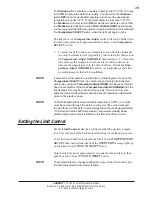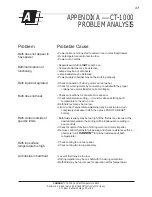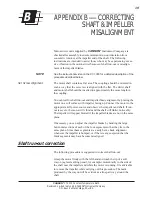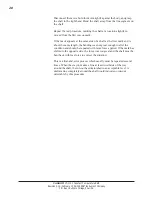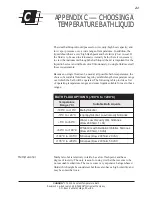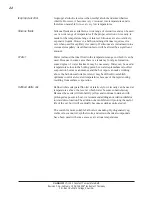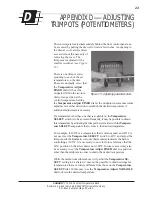
9
CANNON
®
CT-1000 Constant Temperature Bath
Revision 3.1a—February, 1998;
CANNON
®
Instrument Company
P.O . Box 16 • State College, PA • USA
NOTE
Two screws located on either side
of the opening for the motor stirrer
serve as locating pins for the
motor support pad. Do not remove
these screws; the holes in the pad
fit loosely over their heads. The
motor line cord should point toward
the rear of the bath (offset slightly
to the right or left). The motor
stirrer should now lie flat on the top
of the bath.
3. Reattach the top heater housing , making sure that the heater, motor,
and fan cords pass through the left-hand opening (as viewed from the
rear) and that the control probe, over-temperature probe, and level
switch cords exit from the right opening (as viewed from the rear).
The back lip on the rear top cover fits into the slot on the top heater
housing. Line up the holes, insert screws, and tighten.
4. Connect all plugs and probes to the correspondingly labeled sockets
at the rear of the CT-1000 bath unit.
5. Adjust the four feet on the bottom of the bath housing to level the
bath. This should be done
before
filling the bath with fluid.
Inserting viscometer tubes/thermometers
The top cover of the CT-1000 contains seven apertures, 51 mm (2
”
)
in diameter, for the insertion of viscometer tube holders. Two additional
holes are provided for insertion of thermometers.
Inserting viscometer tubes
If necessary, remove the viscometer tube hole cover(s) from the top of
the bath and carefully place the viscometer tube(s), with the proper
holder attached, into the bath through the aperture(s) in the top cover.
NOTE
After filling the bath with fluid, adjust the height of the viscometer tube(s)
to ensure that the liquid under test and/or any timing marks on the tube
are a minimum of 6 mm (¼") below the top level of the liquid.
Thermometer immersion
Proper thermometer immersion is critical for viscosity measurements.
Even a calibrated thermometer will read incorrectly if is it improperly
immersed in the bath. “Total immersion” kinematic viscosity thermom-
eters should be used with the bulb and only the mercury column beneath
the surface of the liquid, but with the emergent stem above the surface at
ambient temperatures.
NOTE
Different thermometers have different immersion requirements. Refer to
the information included with the thermometer in use for specific instruc-
tions.
Figure 12: Installing the motor

















